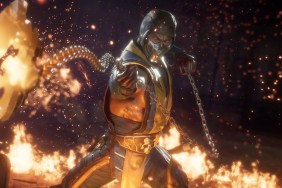Tomb Raider is everything you could want in a blockbuster, AAA video game. It looks drop-dead gorgeous from pretty much every angle; its gameplay, at least in the single player campaign, is silky smooth; and maybe most importantly, it doesn’t sacrifice story development and character growth for bombastic action set-pieces, although there are plenty of those too. Dare I say it, Tomb Raider is the first truly great game of 2013, held back from perfection by only a few nagging issues.
Tomb Raider wears its influences on its sleeve. If I was explaining how Tomb Raider plays to someone that hasn’t been following the game, I’d say it’s the beautiful love child of Uncharted and the Batman Arkham titles. It takes the smooth platforming and gunplay of Naughty Dog’s series and mixes it with the quasi open-world exploration and equipment upgrade elements from Rocksteady’s titles. But to say Tomb Raider is just a by-the-numbers amalgam of those two popular franchises is doing the game a huge disservice. Tomb Raider manages to take the best elements from those brands and mix them together so well that the resulting concoction feels like something wholly fresh and original.
This isn’t your Granddaddy’s Lara Croft, either. Gone are the torpedo boobs and the woman that had no problem drop-kicking a tiger in the face at first sight. This new Lara is younger and still trying to find her calling. The game begins with Lara setting out on an archeologist expedition with a few colleagues and friends, which, unsurprisingly, quickly goes pear shaped when their ship crashes and bunch of island savages come out of the woodwork and start butchering everyone they see. Clearly, hospitality is a foreign concept to them.
Obviously, they miss Lara and a few select members of the ship’s crew, and from there on out, the game’s thematic through line explores what exactly is required from Lara to survive the harshest of living conditions. Consider Tomb Raider a coming-of-age tale; only instead of getting over those weird hairs growing in strange places on your body and the awkward encounters with members of the opposite sex, in this tale our protagonist has to deal with deadly cultists, a mystical island and murder pits. So, you know, basically the same thing.

I have to be honest and say I had no idea Tomb Raider would feel this good to play. The team at Crystal Dynamics did an incredible job animating Lara and then giving the reins over to the player to make them feel like they are in total control of the character’s every move. Whether it’s the platforming segments or the gunfights, of which there are many during the game’s closing hours, everything about Tomb Raider feels just right. Even the little things manage to stand out and feel like triumphs. For instance, when you poke around cover with a weapon drawn, Lara automatically shifts the shoulder she’s aiming down depending what side she’s on. It’s so simple, but goes a long way to show the attention to detail Crystal Dynamics paid to this game.
Even the open world structure works to Tomb Raider’s benefit. This isn’t a game where you just progress level to level until the final credits roll. There is a hub world that you can freely traverse back and forth to revisit old areas in hopes of discovering hidden side-quests and items. As you progress through the game’s story, you’ll unlock new gear, which grants you access to previously unreachable areas. Again, think the Batman Arkham games, not something like Skyrim. Eventually you get to a point where Lara even carries herself like Batman, considering all the gadgets and do-hickies she’s carrying around. It’s an empowering feeling that goes hand in hand with the game’s central narrative thread. Somewhere around the three quarters mark you realize how much of a badass Lara (i.e. you) has become.
This feeling of empowerment is due in large part to the game’s upgrade system. When you reach base camps you can apply skill points to Lara and upgrades to your weapons. Think silencers for pistols and rifles, secondary grips for shotguns, etcetera. Upgrades require salvage to construct, and you can find that spread all over the island. This makes searching every nook and cranny of the place worthwhile if you want to unlock all the upgrades for every weapon. The upgrade system gives purpose to all the backtracking you can freely choose to do thanks to the game’s quasi open-world structure.

Now, I’ve spent almost 800 words raving about Tomb Raider. And I do believe it’s a truly great game, but it’s not perfect. There are a few minor complaints I have with it, some maybe so minor they are barely worth mentioning at all – but I’m going to do it anyway – and some more significant that clearly deserve the stink-eye from a critical perspective.
For starters, what is up with the user interface for quick-time events? I’m honestly not even mad there are quick-time events generally speaking, as they’ve become a staple of the industry that I just kind of shrug off at this point. But in the case of Tomb Raider, the UI is so distracting that quick-time events are made even more obnoxious than they already are.
Additionally, close-quarters combat is really frustrating in the opening hours of the game. If an enemy gets in close, you’re basically screwed. It’s not until later in the game when you can upgrade Lara’s skillset to deal with nearby enemies that you feel in control of your own destiny when a goon is up in your grill. I guess that’s kind of the point in some respect – Lara becomes stronger and more well-versed in how to deal with the obstacles laid out in front of her over time – but it doesn’t change the fact that combat at the beginning of the game leaves a bit to be desire. And it’s a shame, too, considering it doesn’t give the best first impression of what is otherwise a really solid, fluid combat system.
Lastly, and this is the big complaint, the multiplayer sucks. We often say multiplayer components feel like tacked-on additions in order to have one more bullet point on the back of a game box. That’s how multiplayer feels with Tomb Raider. Crystal Dynamics clearly had good intentions with the mode, as there are a bunch of maps to play on, and character skins and upgrades to unlock as you progress through the ranks, but when you break it down to its elements, multiplayer just is not fun to play. It feels broken, even. Close-quarters combat is a mess, and there are some odd design choices in place, like replacing the ability to switch what shoulder you’re aiming down for a crouch. I’d love to hear from someone that actually uses the crouch tactic in this game’s multiplayer mode, since it’s pretty much rush in, run ‘n’ gun at all times.
Definitive Edition
Lara Croft’s second appearance in less than a year is a hit. Tomb Raider: Definitive Edition not only takes advantage of the latest hardware from Microsoft and Sony, but has been touched up considerably to make it the best version yet. Yes, that means it’s even better than the PC version.
Lara Croft’s new model has been given a great deal of attention. Seeing her fight and crawl her way through snow-blasted mountains and many other treacherous environments is a sight for the eyes. You’ll regularly find yourself pausing in your tracks to take in how great the world—and Lara—looks. New effects delivered by TressFX make the tree-dense environments behave closer to our own. Foliage doesn’t ignore the wind like in most other games. The same can be said of Lara’s hair, which funny enough is probably the best-looking hair in any game ever. These little details go a long way toward engrossing you into Lara’s epic journey.
There are some minor new integrations for the Definitive Edition, such as voice commands and in the PS4’s case audio output on the controller, but none of these are noteworthy. However, the inclusion of all post-launch DLC, including costumes to toggle between at campfires, adds welcomed value to the package.
If you have the choice between the PS4 and Xbox One version, you’ll want to go with PS4 in this case. Its framerate remains consistent at or around 60 throughout the epic journey, while the Xbox One tickles the 30 FPS barrier quite often. That said, both versions look outstanding.
Final Verdict
Tomb Raider: Definitive Edition is what Lara Croft aspired to be a year ago. On both the PS4 and Xbox One the experience goes above and beyond what the 360, PS3, and even the PC enjoyed. That’s saying a lot when you take into account that we considered Tomb Raider one of our top 10 games of 2013.
That also means that as great as it is, it’s a re-release of a game that came out not long ago. If you’ve already completed Lara’s latest journey, it’s hard to recommend the Definitive Edition at its steep $59.99 MSRP. On the other hand, if you’re one of the many who mistakenly missed out on one of last year’s greatest, this is the PS4 and Xbox One’s first true AAA title. You’ll have a lot of fun firing 1080p arrows at enemies, and learn just how big of a difference there is between last-gen and current-gen hardware.

Definitive Edition and Final Verdict sections written by Jonathan Leack, CraveOnline’s Gaming Editor. Original review written by Erik Norris.
Review based on PS4 and Xbox One versions. PS4 copy provided by publisher.






